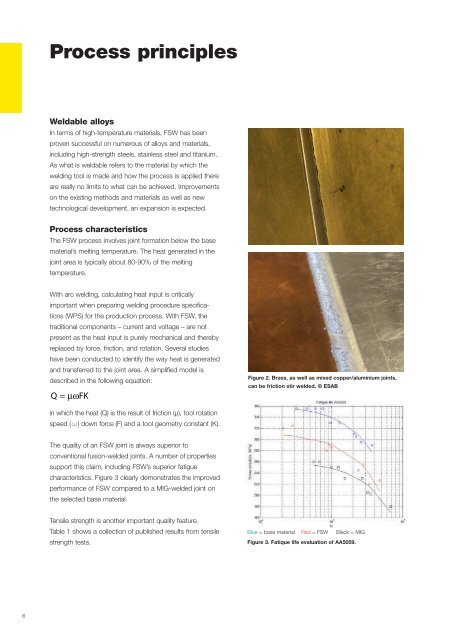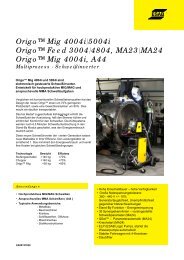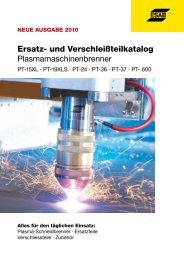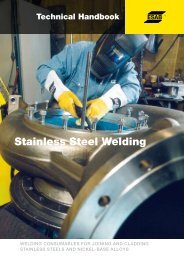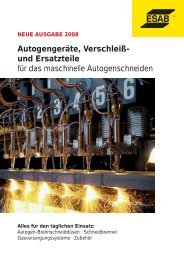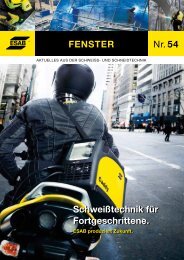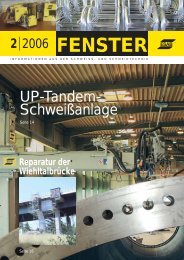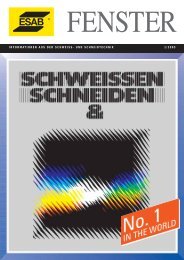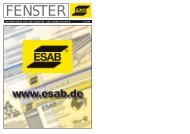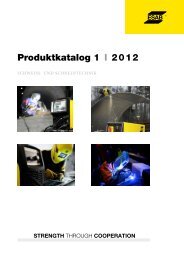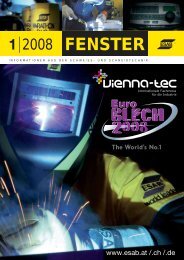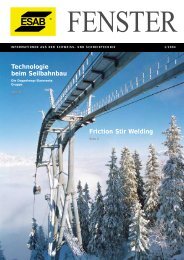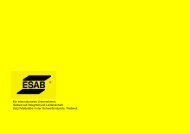Friction Stir Welding - ESAB
Friction Stir Welding - ESAB
Friction Stir Welding - ESAB
You also want an ePaper? Increase the reach of your titles
YUMPU automatically turns print PDFs into web optimized ePapers that Google loves.
Process principlesWeldable alloysIn terms of high-temperature materials, FSW has beenproven successful on numerous of alloys and materials,including high-strength steels, stainless steel and titanium.As what is weldable refers to the material by which theMaterial Condition t (mm)Yield strength,Rp0,2 (Mpa)Tensilestrength,Rm (Mpa)Elongation,A5 (%)WeldratioSource2024-T3 FSW 4.0 304 432 7.6 0.87 Biallas G, et. al19992024-T3 FSW 1.6 325 461 11 0.98 Biallas G, et. al2000<strong>Welding</strong> parametersIn providing proper contactand thereby ensuring a highquality weld, the mostimportant control feature iswelding tool is made and how the process is applied thereare really no limits to what can be achieved. Improvementson the existing methods and materials as well as newtechnological development, an expansion is expected.Process characteristicsThe FSW process involves joint formation below the basematerial’s melting temperature. The heat generated in thejoint area is typically about 80-90% of the melting2024-T3 FSW 310 441 16.3 0.9 Magnusson &Källman 20002024-T3 Solution heattreatedand aged2024-T351 Base 6.4 310 430 12302 445 14.5 0.9 Magnusson &Källman 20015083-0 Base 148 298 23.5 TWI5083-0 FSW 141 298 23 1.00 TWI5083-H321 Base 249 336 16.5 TWI5083-H321 FSW 153 305 22.5 0.91 TWI6013-T6 Aged to T6 h253 291 8.3 0.75 Magnusson &Källman 2002down force (Z-axis). Thisguarantees high quality evenwhere tolerance errors in thematerials to be joined mayarise. It also enables robustcontrol during higher weldingspeeds, as the down force willensure the generation offrictional heat to soften thetemperature.6082-T4 Base 149 260 22.9 SAPA profilesABmaterial.With arc welding, calculating heat input is critically6082-T4 FSW 138 244 18.8 0.93 SAPA profilesABWhen using FSW, the followingimportant when preparing welding procedure specifications(WPS) for the production process. With FSW, thetraditional components – current and voltage – are notpresent as the heat input is purely mechanical and therebyreplaced by force, friction, and rotation. Several studies6082-T4 FSW + heattreatment285 310 9.9 1.19 SAPA profilesAB6082-T6 Base 286 301 10.4 TWI6082-T6 FSW 160 254 4.85 0.83 SAPA profilesAB6082-T6 FSW + heattreatment274 300 6.4 1 SAPA profilesABparameters must be controlled:down force, welding speed,the rotation speed of the weldingtool and tilting angle. Onlyfour main parameters need tohave been conducted to identify the way heat is generated7108-T79 Base 295 370 14be mastered, making FSW€and transferred to the joint area. A simplified model isdescribed in the following equation:Q = µωFKin which the heat (Q) is the result of friction (μ), tool rotationspeed (ω) down force (F) and a tool geometry constant (K).The quality of an FSW joint is always superior toconventional fusion-welded joints. A number of propertiessupport this claim, including FSW’s superior fatiguecharacteristics. Figure 3 clearly demonstrates the improvedperformance of FSW compared to a MIG-welded joint onthe selected base material.Figure 2. Brass, as well as mixed copper/aluminium joints,can be friction stir welded. © <strong>ESAB</strong>7108-T79 FSW 210 320 12 0.867108-T79 FSW and aged 245 350 11 0.95 TWI7475- T76 FSW 381 465 12.8 0.92 Magnusson &Källman 20037475- T76 Solution heattreatedand agedTable 1. Collection of tensile test results for various aluminum alloys.ParameterRotation speedTilting angle<strong>Welding</strong> speedDown forceEffects476 512 10 0.97 Magnusson &Källman 2004<strong>Friction</strong>al heat, “stirring”, oxide layer breaking and mixing of material.The appearance of the weld, thinning.Appearance, heat control.<strong>Friction</strong>al heat, maintaining contact conditions.Table 2. Main process parameters in friction stir welding.ideal for mechanised welding.Tools<strong>Welding</strong> tool design is criticalin FSW. Optimising toolgeometry to produce moreheat or achieve more efficient“stirring” offers two mainbenefits: improved breakingand mixing of the oxide layerand more efficient heatgeneration, yielding higherwelding speeds and, of course,Tensile strength is another important quality feature.Table 1 shows a collection of published results from tensilestrength tests.Blue = base material Red = FSW Black = MIGFigure 3. Fatique life evaluation of AA5059.Alloy group Temperature range in °CAluminium alloys 440…550Magnesium alloys 250…350Copper alloys 600…900Carbon and low-alloy steels 650…800Titanium alloys 700…950enhanced quality.The simplest tool can bemachined from an M20 boltwith very little effort. It hasproved feasible to weld thinaluminium plates, even withTable 3. <strong>Welding</strong> temperature range of various alloys.tooling as simple as this,67


